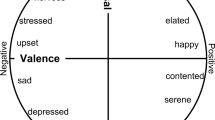Abstract
Song indexing using emotions is an interesting area of research as it enables authentic analysis based on listener’s emotions. In this work, we propose a multi-neural network architecture with learning accuracy based weights algorithm in order to classify the emotions of listener’s based on self-rated valence, arousal and dominance values into three emotion categories. This classification data is then used in order to identify the major emotion induced by the song, which is then compared with the tags present on that particular song on the last.fm website. The training and testing data for the multi-neural network model is taken from the DEAP dataset and we obtained 85% accuracy in indexing the songs.



Similar content being viewed by others
References
Aneja D, Colburn A, Faigin G, Shapiro L, Mones B (2016) Modeling stylized character expressions via deep learning. In: Proceedings of the 13th asian conference on computer vision. Springer
Bhandari P, Bijarniya RK, Chatterjee S, Kolekar M (2018) Analysis for self-taught and transfer learning based approaches for emotion recognition. In: 5th IEEE international conference on signal processing and integrated networks (SPIN) (pp 509–512)
Choi K, Fazekas G, Sandler MB, Cho K (2017) Transfer learning for music classification and regression tasks. In: Proceedings of the 18th international society for music information retrieval conference (ISMIR), pp 141–149
Gautam G, Choudhary K, Chatterjee S, Kolekar MH (2017) Facial expression recognition using Krawtchouk moments and support vector machine classifier. In: 2017 Fourth international conference on image information processing (ICIIP). IEEE, pp 1–6
Ghosal D, Kolekar MH (2018) Music genre recognition using deep neural networks and transfer learning. Proc. Interspeech:2087–2091
He K, Zhang X, Ren S, Sun J (2016) Deep residual learning for image recognition. In: Proceedings of the IEEE conference on computer vision and pattern recognition, pp 770–778
Huang H, Hu Z, Wang W, Wu M (2020) Multimodal emotion recognition based on ensemble convolutional neural network. IEEE Access 8:3265–3271. https://doi.org/10.1109/ACCESS.2019.2962085
Kanade T, Cohn JF, Tian Y (2000) Comprehensive database for facial expression analysis. In: Proceedings of the Fourth IEEE international conference on automatic face and gesture recognition (FG’00), Grenoble, France, pp 46–53
Koelstra S, Muhl C, Soleymani M, Lee JS, Yazdani A, Ebrahimi T, Pun T, Nijholt A, Patras I (2012) DEAP: A database for emotion analysis; using physiological signals. IEEE Transactions on Affective Computing 3 (1):18–31
Kolekar MH, Sengupta S (2015) Bayesian network based customized highlight generation for broadcast soccer videos. IEEE Trans Broadcasting 61 (2):195–209
Krizhevsky A, Sutskever I, Hinton GE (2012) Image net classification with deep convolutional neural networks. In: Advances in neural information processing systems, pp 1097–1105
Kumar JS, Bhuvaneswari P (2012) Analysis of electroencephalography (EEG) signals and its categorization–a study. Procedia Eng:38
Liu Y, Sourina O (2013) EEG databases for emotion recognition. In: 2013 international conference on cyberworlds. IEEE, pp 302–309
Liu W, Zheng W-L, Lu B-L (2016) Emotion recognition using multimodal deep learning. In: International conference on neural information processing. Springer, Cham, pp 521–529
Lucey P, Cohn JF, Kanade T, Saragih J, Ambadar Z, Matthews I (2010) The extended Cohn-Kanade Dataset (CK+): A complete expression dataset for action unit and emotion-specified expression. In: Proceedings of the third international workshop on CVPR for human communicative behavior analysis (CVPR4HB 2010), San Francisco, USA, pp 94–101
Tzanetakis G, Cook P (2002) Musical genre classification of audio signals. IEEE Trans Speech Audio Process 10(5):293–302
Tripathi S, Shrinivas A, Sharma RD, Mittal S, Bhattacharya S (2017) Using deep and convolutional neural networks for accurate emotion classification on DEAP dataset. In: Twenty-Ninth IAAI conference
Varghese AA, Cherian JP, Kizhakkethottam JJ (2015) Overview on emotion recognition system. In: 2015 International conference on soft-computing and networks security (ICSNS). IEEE, pp 1–5
Xie O, Liu Z-T, Ding X-W (2018) Electroencephalogram emotion recognition based on a stacking classification model. In: 2018 37th Chinese control conference (CCC) (Wuhan: IEEE), pp 5544–5548. https://doi.org/10.23919/ChiCC.2018.8483496
Xu C, Maddage NC, Shao X, Cao F, Tian Q (2003) Musical genre classification using support vector machines. IEEE Int Conf on Acoustics, Speech, and Signal Processing (ICASSP) 5:V–429
Author information
Authors and Affiliations
Corresponding author
Additional information
Publisher’s note
Springer Nature remains neutral with regard to jurisdictional claims in published maps and institutional affiliations.
Rights and permissions
About this article
Cite this article
Gonegandla, P., Kolekar, M.H. Automatic song indexing by predicting listener’s emotion using EEG correlates and multi-neural networks. Multimed Tools Appl 81, 27137–27147 (2022). https://doi.org/10.1007/s11042-021-11879-9
Received:
Revised:
Accepted:
Published:
Issue Date:
DOI: https://doi.org/10.1007/s11042-021-11879-9




